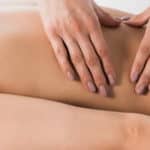As healthcare professionals who navigate through their medium using touch, massage therapists are susceptible to the strengths and weaknesses of their own palpatory skills. A practitioner with a sensitive and responsive touch can adjust his or her applications accordingly, while one lacking these skills can make a faulty assessment, deliver a mediocre massage or even inflict accidental pain. While developing the ability to interpret what is felt underneath one’s hands is a valued massage therapy skill, it is also one of the more obscure concepts to teach.
Although it is of major importance, memorizing a map of human anatomical structures is not enough preparation for learning how and where to apply bodywork. Because people come in all shapes and sizes, you can not simply superimpose any given diagram of anatomical landmarks on a client to locate the structure or muscle group being searched for. Most experts agree that there are several components to mastering palpation – including combining the imaginative mind and drawing from the therapist’s knowledge of anatomy.
According to Leon Chaitow, ND, DO, “Palpation cannot be learned by reading or listening; it can only be learned by palpation.” He also says that an open mind is vital to the task of learning palpatory literacy – practitioners with the greatest degree of rigidity, in terms of their training, often have the hardest time allowing themselves to feel new feelings and sense new sensations.
In accordance to John Upledger, DO, OMM, the developer of CranioSacral Therapy, “Learning to trust your hands is not an easy task. You must learn to shut off your conscious, critical mind while you palpate for subtle changes in the body you are examining. You must adopt an attitude so that you may temporarily accept without question those perceptions which come into your brain from your hands. After you have developed your palpatory skill, you can criticize what you have felt with your hands. If you criticize before you learn to palpate, you will never learn to palpate.”
Each tissue has a different tactile sensation. Since a practitioner’s fingers can literally only contact the skin, sensing the structures underneath is akin to trying to recognize types of food while blindfolded and wearing winter gloves. Below are some exercises devised by Mary Ann Foster, massage therapist and movement educator, to help develop a bodyworker’s palpation skills of skin, superficial fascia, deep fascia, tendons, ligaments and muscle.
To explore the skin and superficial fascia:
- Lightly stretch the top layer of skin in one direction without compressing or sliding it. Release and sense how it recoils.
- Press the skin into the superficial fascia, which should feel thick, spongy and springy. Gently explore kneading this layer, much like a cat would paw a pillow.
- Lift and roll the skin and superficial fascia in several areas, noting variances in their thickness.
To explore the deep fascia:
- Compress the skin and superficial fascia, then slide them over the deep fascia underneath, which feels slick, like slipping on ice.
- Palpate deep fascia in various parts of the body, noticing variances in texture and elasticity.
- Contrast moving across deep fascia over bone and muscle.
- Pin the deep fascia against its underlying muscle or bone. Stretch it to end range and hold until you feel it yield, then stretch a bit further.
To explore tendons and ligaments:
- Palpate the tendons above the wrist, which will feel like slippery cords. Follow the tendon up the arm, noting what the transition from tendon to muscle feels like. One is fibrous and ropy, the other meaty and substantial.
- Palpate the patellar tendon above the knee. Differentiate muscle from tendon by contracting and relaxing the quadriceps as you palpate.
- Run your finger across collateral ligaments of the knee or wrist. Notice how the ligaments feel different from tendons.
To explore muscle tissue:
- With a partner, explore tracing different muscles. Follow along the fibers and fascicles from one end of a limb to the other.
- Contrast palpating muscles along and across the fibers.
- Explore squeezing round muscles like the deltoid and triceps, pressing into muscles over bones like the infraspinatus, and lifting the edges of flat muscles like the latissimus dorsi.
Although cognitive learning is essential, the ability to listen to what our hands are telling us is a vital component of delivering an effective massage. By developing palpation skills and carefully listening to a client’s tissue with attentive hands, bodyworkers can transform into masters of their profession. As thinking and sensing merge together, the art and science of palpation takes full form – leading to a stronger and more therapeutic connection for both practitioner and client.
Recommended Study:















